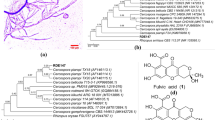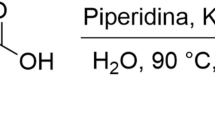Abstract
The effects of fluconazole, a bis-triazole antifungal agent, on the sterol and carbohydrate composition ofCandida albicans, Candida tropicalis, Candida krusei andCandida parapsilosis were investigated. Exposure ofCandida species to fluconazole resulted in a profound depletion of ergosterol with a corresponding increase in lanosterol content versus control cells. Carbohydrate analysis revealed a significant increase in chitin and either a decrease(Candida albicans, Candida tropicalis andCandida parapsilosis) or an increase(Candida krusei) in glucan content in fluconazole-treated cells. The decreased ergosterol and increased lanosterol content is consistnet with 14-alpha-demethylase inhibition by fluconazole. The increase in cell wall chitin is most likely due to deregulation of chitin synthesis secondary to ergosterol depletion in the cell membrane. Because chitin, glucan and ergosterol are critical components of the fungal cell, perturbation of the production and localization of these components by fluconazole is likely to contribute to the selective toxicity of this compound toCandida species and other fungi.
Similar content being viewed by others
References
DeWit S, Weert D, Goossens H, Clumeck N: Comparison of fluconazole and ketoconazole for oropharyngeal candidiasis in AIDS. Lancet 1989, i: 746–748.
Galgiani JN: Fluconazole, a new antifungal agent. Annals of Internal Medicine 1990, 113: 177–179.
Saag MS, Dismukes WE: Azole antifungal agents: emphasis on new triazoles. Antimicrobial Agents and Chemotherapy 1988, 32: 1–8.
Sugar AM, Saunders C: Oral fluconazole as suppressive therapy of disseminated cryptococcosis in patients with acquired immunodeficiency syndrome. American Journal of Medicine 1988, 85: 481–491.
Marriott MS, Richardson K: The discovery and mode of action of fluconazole. In: Fromtling RA (ed): Recent trends in the discovery, development, and evaluation of antifungal agents. JR Prous Science Publishers, Barcelona, 1987, p. 81–82.
Van den Bossche H: Biochemical targets for azole antifungal derivatives: hypothesis on the mode of action. In: McGinnis MR (ed): Current topics in medical mycology, Volume 1. Srpinger Verlag, New York, 1985, p. 313–351.
Van den Bossche H, Willemsens G, Cools W, Marichal P, Lauwers W: Hypothesis on the molecular basis of the antifungal activity of N-substituted imidazoles and triazoles. Biochemical Society Transactions 1983, 11: 665–667.
Marichal P, Gorrens J, Van den Bossche H: The action of itraconazole and ketoconazole on growth and sterol synthesis inAspergillus fumigatus andAspergillus niger. Sabouraudia: Journal of Medical and Veterinary Mycology 1984, 22: 13–21.
Borgers M: Ultrastructural correlates of antimycotic treatment. In: McGinnis MR (ed): Current topics in medical mycology, Volume 2. Springer Verlag, New York, 1988, p. 1–39.
Pfaller MA, Riley J, Koerner T: Effects of terconazole and other azole antifungal agents on the sterol and carbohydrate composition ofCandida albicans. Diagnostic Microbiology and Infectious Diseases 1990, 13: 31–35.
Pfaller MA, Gerarden T: Susceptibility of clinical isolates ofCandida spp. to terconazole and other azole antifungal agents. Diagnostic Microbiology and Infectious Diseases 1989, 12: 467–471.
Milewski S, Chmara H, Borowski E: Antibiotic tetaine-a selective inhibitor of chitin and mannoprotein biosynthesis. Archives of Microbiology 1986, 145: 234–240.
Trevelyan WE, Harrison JS: Studies on yeast metabolism. Biochemical Journal 1952, 50: 298–303.
Dische Z: Color reactions of hexosamines. In: Whistler RL, Wolfrom MZ (ed): Methods in carbohydrate chemistry. Academic Press, New York, 1962, p. 507–512.
Roberts RL, Blowers B, Slater ML, Cabib E: Chitin synthesis and localization in cell division cycle mutants ofSaaccharomyces cerevisiae. Molecular and Cell Biology 1983, 3: 922–930.
Rogers HJ, Perkins HR, Ward JB: Biosynthesis of cell walls and membranes. Chapman and Hall, London, 1980, p. 478–507.
Gooday GW: The enzymology of hyphal growth. In: Smith JE, Berry DR (ed): The filamentous fungi: developmental biology, Volume 3. Edward Arnold, London, 1978, p. 51–77.
Chiew YY, Sullivan PA, Shepherd MG: The effects of ergosterol and alcohols on germ-tube formation and chitin synthase inCandida albicans. Canadian Journal of Biochemistry 1982, 60: 15–20.
Surarit R, Shepherd MG: The effects of azole and polyene antifungals on the plasma membrane enzymes ofCandida albicans. Journal of Medical and Veterinary Mycology 1987, 25: 403–413.
Pfaller M, Riley J, Koerner T: Effects of cilofungin (LY121019) on carbohydrate and sterol composition ofCandida albicans. European Journal of Clinical Microbiology and Infectious Diseases 1989, 8: 1067–1070.
Author information
Authors and Affiliations
Rights and permissions
About this article
Cite this article
Pfaller, M., Riley, J. Effects of fluconazole on the sterol and carbohydrate composition of four species ofCandida . Eur. J. Clin. Microbiol. Infect. Dis. 11, 152–156 (1992). https://doi.org/10.1007/BF01967067
Issue Date:
DOI: https://doi.org/10.1007/BF01967067




